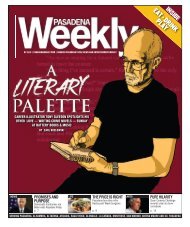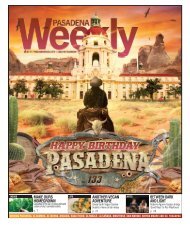October Arroyo 2018
Create successful ePaper yourself
Turn your PDF publications into a flip-book with our unique Google optimized e-Paper software.
–continued from page 11<br />
the Hall of the Jade Camellia, then splits<br />
into two groups to watch various scenes<br />
being performed on the east and west<br />
sides of the lake. Both groups will see the<br />
same scenes, but in a different order.<br />
The inspiration for Nightwalk came<br />
to Lai when he toured this garden three<br />
years ago. He shared his idea with Travis<br />
Preston, dean of the CalArts School of<br />
Theater, who’d wanted to do a project<br />
with him through their Center for New<br />
Stan Lai<br />
Performance. “We’re not really looking<br />
for plays, we’re looking for artists we want<br />
to work with,” Preston says in a phone<br />
interview. “Stan’s a writer and director at the same time. He’s devising the work as he’s<br />
rehearsing it; that’s very consistent with the kind of experimentation we’re interested in.<br />
There’s also a lyricism in Stan’s work I find very moving.”<br />
Lai, who shuttles between Taiwan and China, conducted a workshop in 2016 with<br />
prospective actors and participants at CalArts and the Chinese Garden. His idea was to<br />
weave together two stories: one involving<br />
Henry Huntington, the railroad magnate<br />
whose collections and estate make<br />
up the core of The Huntington, and the<br />
other, the Chinese opera classic The Peony<br />
Pavilion.<br />
The Peony Pavilion is a tragicomedy<br />
written by Tang Xianzu in 1598 — the<br />
original play ran for 55 scenes and took<br />
over 20 hours to perform. (Nightwalk runs<br />
Chenxue Luo of the Shanghai<br />
Kunqu Troupe, performing the role<br />
of the Opera Singer<br />
Hao Feng as The Playwright, a<br />
Chinese man of letters from the<br />
Ming Dynasty<br />
about 90 minutes.) In it a young maiden,<br />
Du Liniang, enters a garden where she<br />
dreams of a handsome scholar, Liu Mengmei,<br />
and tumbles head over heels in love<br />
with him. She falls so deeply that when she awakens, she wastes away pining for him.<br />
Later, this same scholar visits her garden and has a dream about her. In the dream he’s<br />
encouraged to find her grave and exhume her body — which he does, and she miraculously<br />
comes back to life, uncorrupted.<br />
“It’s one of the most famous Chinese plays, but not well known outside of China,”<br />
says Lai in his deep, measured voice. “It’s so steeped in the tradition that I’m very<br />
interested in and write about myself a lot,<br />
which is the reality of dreams, the reality<br />
of art, also my own interest in the creative<br />
process itself — these are the things that<br />
are blending together in the garden here.”<br />
In his play, the playwright becomes part<br />
of the story. “He’s in the midst of writing<br />
The Peony Pavilion,” says Lai, and Du<br />
Liniang becomes his imagined heroine<br />
and muse. “Du Liniang is trying to teach<br />
him how to write.”<br />
The Western part of the story takes<br />
place in the early 1920s, when Henry<br />
Huntington acquires the Thomas Gainsborough<br />
painting, The Blue Boy, today a pride and joy of the Huntington art collection<br />
and the subject of a concurrent exhibition (see page 15). His curator also introduces<br />
him to Chinese opera, via an excerpt from The Peony Pavilion, which is performed in<br />
Nightwalk on a rotating basis by two stars of the Shanghai Kunqu Troupe. After our interview,<br />
Lai invites me to stay for the rehearsal and the kunqu performance. This takes<br />
PHOTO: Top left, courtesy of Stan Lai; bottom left photos by Angel Origgi, courtesy of CalArts Center for New Performance.<br />
12 | ARROYO | 10.18

















